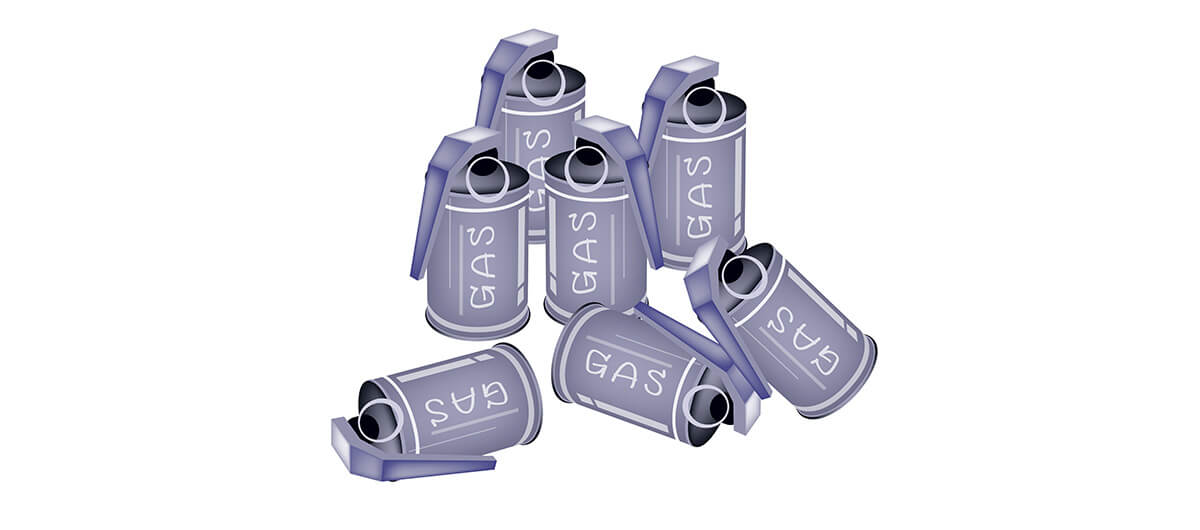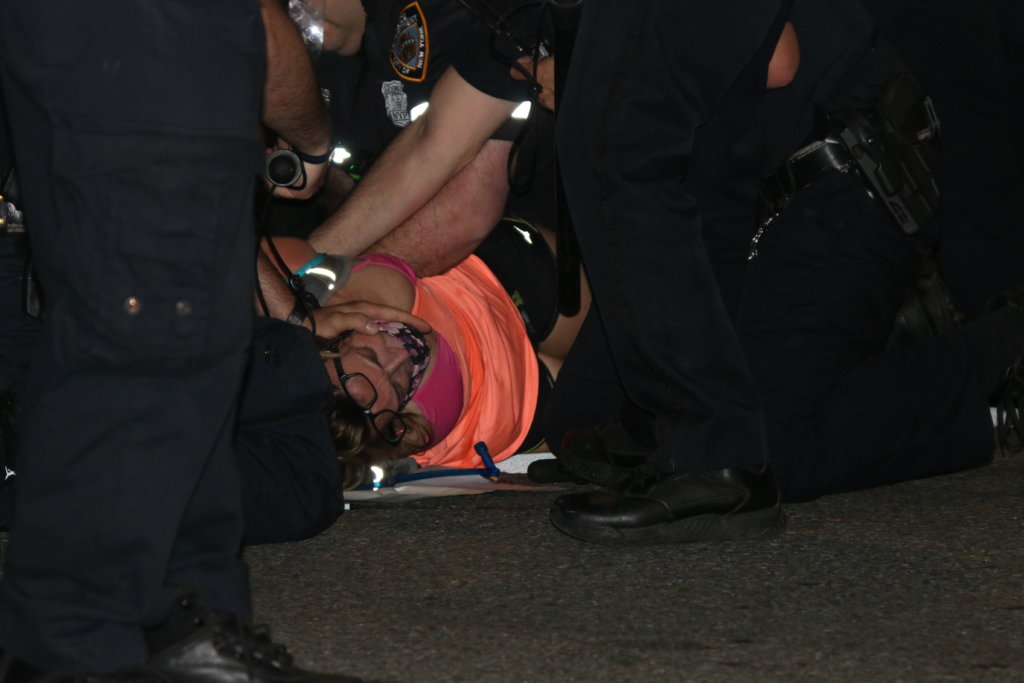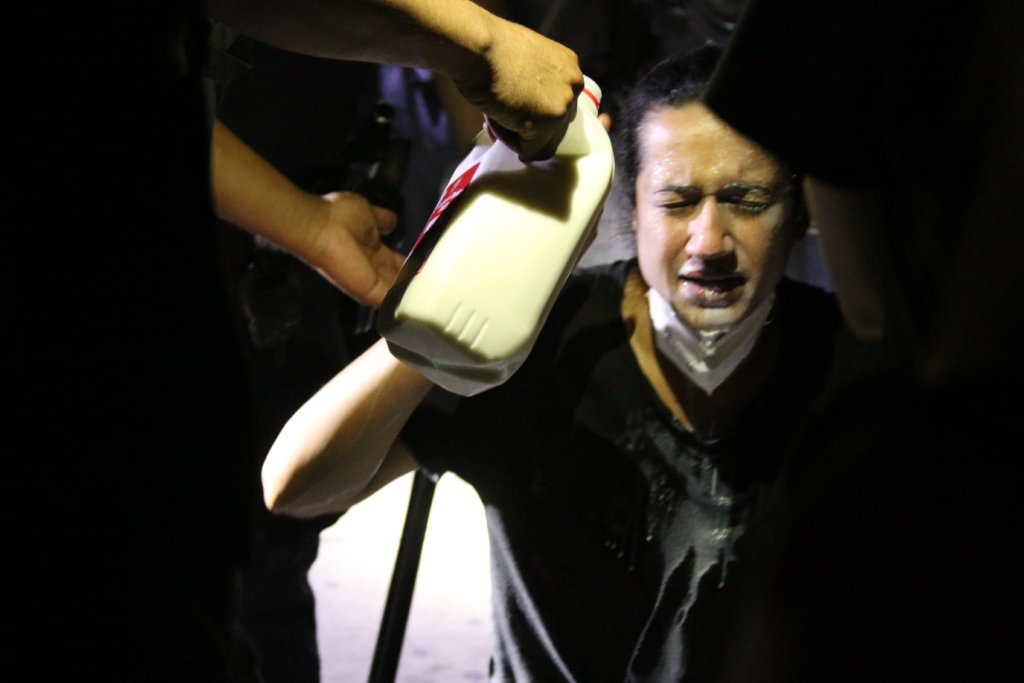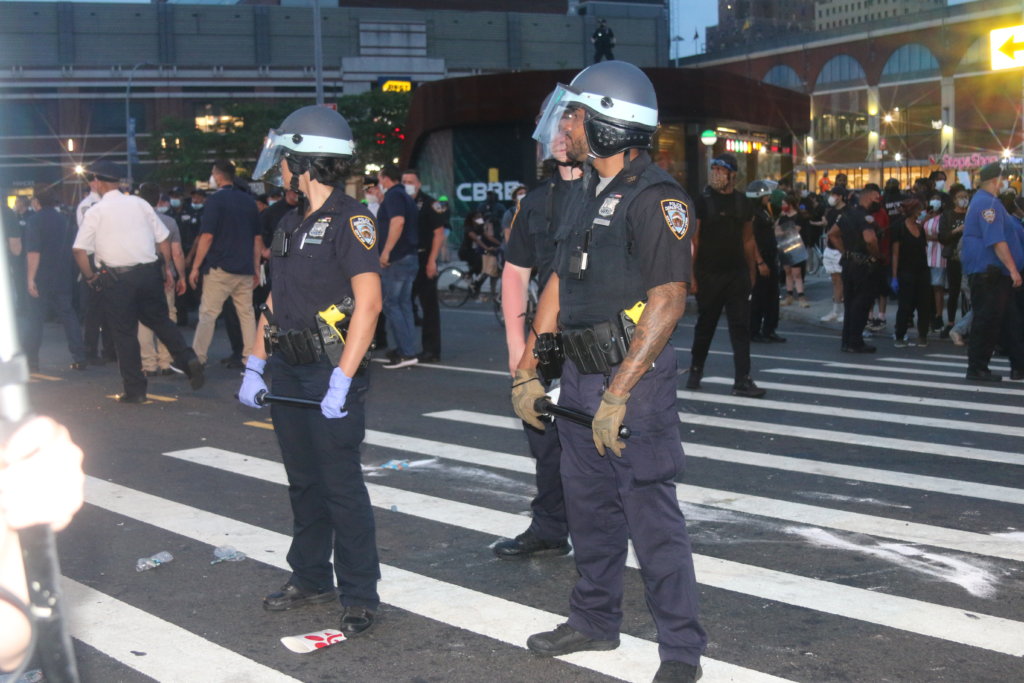

Power
‘Less-Lethal’ Weapons Still Can Kill
Pepper spray, tear gas, and rubber bullets are dangerous enough, but add inadequate police training and high tensions during protests, and less-lethal force is a recipe for disaster.
This article was made possible because of the generous support of DAME members. We urgently need your help to keep publishing. Will you contribute just $5 a month to support our journalism?
In Brooklyn’s Cadman Plaza, hundreds of peaceful protesters, along with journalists like myself, had gathered to demand an end to police brutality on the night of June 3. They held signs with slogans like, “Defund the NYPD,” and, “Who do you call when the police are the murderers?” By all accounts, the group was quieter and calmer than many that had taken to the streets the previous nights. But just before 9 p.m. the calmness in their air twisted into a convulsive tension, and in a fraction of a second police were pinning young women to the ground and pushing cyclists off their bikes. Almost like divine intervention, rain came pouring down on a crowd that seemed to have more officers in riot gear than protesters, dispersing the group. As the police made a few more arrests, the crowd thinned out and a jubilant officer said, “Nothing disperses a crowd like the rain.”
The decision to deploy so-called “less-lethal” force onto protesters or any individual is, in many cities, a decision left up to the individual officer. The Los Angeles Police Department’s Use of Force Tactics-Directive notes that officers must be “objectively reasonable” in their judgment of when to use force. However, the directive also leaves “allowance for the fact that police officers are often forced to make split-second judgments.” The Fort Lauderdale Police Department’s less-lethal weapons policy notes that, for conductive electrical weapons like tasers, the decision to use these weapons “will ultimately rest on the officer’s judgment.” The NYPD’s policy offers officers a list of criteria to consider in determining whether use of force is applicable, including “the nature and severity of the crime/circumstance” and the “immediacy of the perceived threat or harm” to those in the area. During the George Floyd protests, NYPD officers have quickly garnered the reputation of abusing that discretion: People were beaten and injured, journalists were pepper-sprayed and arrested.

A study by the University of Chicago Law School published in response to police behavior during the George Floyd protests found that “none of the police use of lethal force policies from the 20 largest U.S. cities during 2017-2018 complied with basic international human rights law and standards.”
“Law enforcement has great discretion on when to use non-lethal weapons,” said Adam Scott Wandt, an assistant professor of public policy at John Jay College of Criminal Justice and a former sworn law enforcement officer. “When police officers are equipped heavier than normal, it seems that things get out of hand quicker than normal,” he added, noting the body armor and riot gear that police have been donning across the country.
Selena Michelle, an activist based in New York City, was on the streets early on. On May 29, Michelle says she was peacefully protesting in Brooklyn when an officer “aggressively” wielded his baton at her, shoving it into her arm, while other members of the NYPD used a metal barricade to push the crowd.
“I just kind of looked at him like, ‘what are you doing? You can’t keep pushing it!’ And he just started screaming at me to move and he continued pushing the baton into my arm,” she says.
The slow and senseless killing of George Floyd shocked Americans out of their sedentary COVID-19 self-quarantine comas, and into the streets for unprecedented protests across nearly every major U.S. city. The vast majority of protests have been peaceful and grow even more organized as the movement enters its fourth week. But clouds of tear gas, streams of pepper spray, and images of bloodied protesters and observers alike have illustrated that use of force is rampant among U.S. law enforcement.
“The violence that was happening was really more incited by the police,” Michelle said of her experience protesting in Brooklyn. “I just don’t understand it.”
Wandt noted that there’s one variable that might drive law enforcement to prematurely deploy weapons or fuel their aggression: fear. “I would be remiss if I didn’t bring it up: Police officers are scared,” he said. “The police officers are scared that they’re not going to make it home to their families. There’s a lot of testosterone or fear that drives these things and it’s just a lose-lose situation for everybody.”
The many methods of riot control that have been photographed and reported over the past weeks fall into the category of “less-lethal weapons.” They’re crowd-control tools that are allegedly meant to only inflict pain, disorient, or incapacitate individuals without risking death, though the United Nations recognizes that these weapons can still cause death. And that risk increases when repetition, lack of training, or intentional misuse are at play. Most police forces in the U.S. are controlled at the state or local level, so standards for when or which methods of less-lethal force are deployed vary. Over the years, the Department of Justice has issued guidelines on use of force, but police departments or other local law enforcement aren’t required to codify such guidelines. Federal authority over local law enforcement, like many local and state policy issues, is limited by the Constitution. The result is an extremely wide spectrum of potential harm that bottoms out with mild bruising or burning eyes, but peaks at lethality.

Less-lethal weapons include chemical agents such as tear gas and pepper spray, projectiles like rubber bullets and sponge grenades, energy devices like Tasers, and blunt force tools like batons. But the list doesn’t end there. In fact, throughout the protests in Brooklyn, officers have appeared to use bicycles and barricades to attack crowds. Michelle’s description of being pushed and shoved into metal barricades has been a recurring one. One journalist I witnessed reporting in Flatbush on May 30 was left with several inch-long gashes after an officer hit him with the chain side of a bike. In Cadman Plaza on June 3, I saw officers grab a bike from under a small woman who was quietly standing on the outer edge of a protest. As she fell to the ground, officers began throwing seized bicycles into a small fenced-in green area.
Meanwhile, the potential for misuse of chemical agents like tear gas is high. The substance, which is actually a powder usually containing the chemicals chloroacetophelesse (CN) and chlorobenzylidenemalolessitrile (CS), is banned by the 1925 Geneva Protocol in contexts of war. But the U.S. maintained a carve-out to allow its use for riot control. The Centers for Disease Control and Prevention notes that continued or acute exposure to tear gas can cause “respiratory failure possibly resulting in death.” Misuse of projectiles, or anything shot from a riot gun, also has significant potential for life-changing injury. Several protesters and journalists have reportedly been shot at close range by riot guns during the George Floyd protests. Linda Tirado, a photojournalist covering protests in Minneapolis, was shot in the eye by a projectile and left partially blind.
Another less-lethal weapon that protesters have spotted lurking around New York City is the LRAD, or long-range acoustic device. This device uses high-decibel sirens or messages to disperse crowds, but can cause hearing loss and neurological issues if used at close range. Individuals alleged they were injured by the NYPD’s use of the LRAD during 2014 protests surrounding the decision not to indict Eric Garner’s killer. Though a lawsuit was filed against the police department detailing injuries the plaintiff’s attributed to their exposure to the LRAD, including chronic migraines and nerve damage, it didn’t go anywhere.
“They have been known to trigger seizures,” Wandt said of the LRAD, “and there is a large chance they could cause damage to the brain.”
It’s unclear exactly how many people during these current protests have sustained lasting and severe injuries from police using less-lethal force. Accurately tracking law enforcement’s use or misuse of force is next to impossible, simply because local agencies in the U.S. are not required to report incidents to any federal body. Even The Washington Post’s “Fatal Force” database aggregates its numbers primarily based on local news reports — not government records. With over 18,000 law enforcement departments across the country, no comprehensive oversight over the use of force exists. For agencies that do report incidents, no standardization in record-keeping exists. So, the margin for error is wide and it’s unlikely a comprehensive account of how less-lethal weapons were abused during these protests will ever be possible.
U.S. security forces misusing less-lethal weapons is commonplace and not exclusive to police or crowd-control situations. In 2019, a Department of Justice (DOJ) investigation into the Boyd County Detention Center in Kentucky found that correctional officers were using less-lethal weapons against detainees in ways that violated the U.S. Constitution.

The records compiled by DOJ showed multiple cases where less-lethal weapons were used in ways that violated the Eighth Amendment, which protects prisoners from “cruel and unusual punishment.” In the report, the department notes that “jail officials show deliberate indifference” and that they seemed to be intentionally inflicting harm on prisoners. Though the department didn’t say it outright, its descriptions are congruent with part one of the U.S. Code definition of torture: “Torture means an act committed by a person acting under color of law specifically intended to inflict severe physical or mental pain or suffering (other than pain or suffering incidental to lawful sanctions) upon another person within his custody or physical control.”
On several occasions at the Boyd County Detention Center, corrections officers used “electronic control devices” like tasers on detainees who were already restrained and apparently posing no threat to themselves or others, according to the DOJ’s report. In one particularly harrowing account cited in the DOJ investigation, officers restrained a pre-trial (not yet sentenced) woman after pepper spraying her, naked, in the shower. She was then tased four times. When she tried to return to the shower, she was again pinned down to the floor, where two officers held her down by each of her legs while a third deployed pepper spray directly into her vagina. DOJ noted that it was next to impossible to know exactly how many times similar incidents occurred because officers weren’t required to report every time they deployed less-lethal weapons, and the facility had a history of poor record-keeping. Several detainees at the Boyd County Detention Center have died in custody, and the facility remains open.
The unbridled aggression that law enforcement around the country used particularly in the early days of the George Floyd protests have inspired multiple lawsuits against police departments. The American Civil Liberties Union announced on June 3 that they’d filed a lawsuit against the Minneapolis Police Department for their use of force targeting journalists during the protests. Tirado is also suing the police department. However, Michelle said she doesn’t feel that the national dialogue surrounding use of force will change much, at least in New York’s police force.
“I don’t think that there are enough people in the NYPD that feel that those actions were problematic,” she said of the incidents over the past two weeks. “And even if they do, I think that people are way too afraid to speak out against what is occurring.”
Before you go, we hope you’ll consider supporting DAME’s journalism.
Today, just tiny number of corporations and billionaire owners are in control the news we watch and read. That influence shapes our culture and our understanding of the world. But at DAME, we serve as a counterbalance by doing things differently. We’re reader funded, which means our only agenda is to serve our readers. No both sides, no false equivalencies, no billionaire interests. Just our mission to publish the information and reporting that help you navigate the most complex issues we face.
But to keep publishing, stay independent and paywall free for all, we urgently need more support. During our Spring Membership drive, we hope you’ll join the community helping to build a more equitable media landscape with a monthly membership of just $5.00 per month or one-time gift in any amount.
















































































